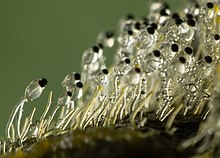Mucorales
This article includes a list of general references, but it lacks sufficient corresponding inline citations. (October 2022) |
| Mucorales | |
|---|---|

| |
| Pilobolus crystallinus sporangia | |
| Scientific classification | |
| Domain: | Eukaryota |
| Kingdom: | Fungi |
| Division: | Mucoromycota |
| Subdivision: | Mucoromycotina |
| Order: | Mucorales |
| Families | |
|
See text | |
The Mucorales is the largest and best-studied
Systematics
The order includes: 11
) appear to be polyphyletic. Today, the traditional system is still largely in use, as further studies are needed to reconcile morphological and molecular concepts of families and genera.Families

The order consists of the following families:
- Backusellaceae
- Choanephoraceae
- Cunninghamellaceae
- Mucoraceae
- Mycotyphaceae
- Phycomycetaceae
- Pilobolaceae
- Radiomycetaceae
- Saksenaeaceae
- Syncephalastraceae
- Umbelopsidaceae
Description
Mucoralean fungi are typically fast-growing, and their wide
Many are known by the damage they do to stored food such as bread. Others can cause mucormycosis, generally in immunosuppressed patients, or patients already infected with other diseases.
Life cycle
The sporangiospores are asexual mitospores (formed via mitosis), produced inside sporangia (thousands of spores) or sporangioles (single or few spores). They are released when mature by the disintegration of the sporangium wall, or as a whole sporangiole that separates from the sporangiophore.
The sporangiospores
In
The original report of sex in fungi, occurred two centuries ago, based on observations of the fungus Syzygites megalocarpus (Mucoromycotina) (reviewed by Idnurm[1]). This species, was subsequently used in 1904, to represent self-fertile species when the concept of two major mating strategies were developed for the fungi. These strategies are homothallism for self-fertile fungi and heterothallism for self-incompatible, outcrossing fungi.
Ecology
Most Mucoralean species are
References
- PMID 21908600.
